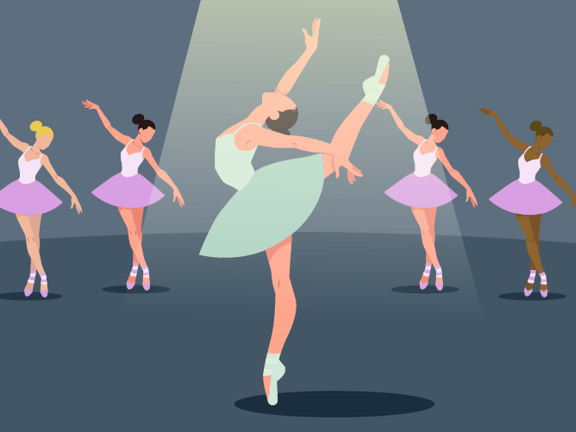From Dancing to Dunking: Rotations of the Scapula
November 21, 2019
6 min. read

In a previous article, we looked at the role of the scapula and the ways in which its anatomy allows for complex movements. This time around, were going to dive deeper into a specific type of scapular movementrotation.
Rotations of the Scapula
Normal scapular function occurs as a result of three-dimensional scapular motions and translations that are integrated and coordinated with arm and trunk motions to complete task-specific activities for the shoulder and arm. Studies using both motion tracking systems and indwelling bone pins have demonstrated that total scapular movement is a composite of motions (rotations around axes) and translations (sliding along a surface).1, 2, 3, 4
The three observable rotary motions are:
Upward/downward rotation around an axis perpendicular to the scapular body
Internal/external rotation around a vertical axis along the medial border
Anterior/posterior tilt around a horizontal axis along the scapular spine
These rotations only occur due to the clavicular attachment connecting the scapula to the manubrium. This anatomical construct is why the scapular rotations are accessory motionsin other words, involuntary. While you do not consciously control your ability to rotate your scapula in any direction, the ability to maximize the rotations can be affected if acromioclavicular joint/clavicle injury occurs.5, 6, 7
Upward Rotation
The traditional description of upward rotation is "synchronous contraction of the upper trapezius, lower trapezius, and serratus anterior." However, this description is not accurate.
The more accurate description of upward rotation is coupled motion between the middle trapezius and serratus anterior with stabilization provided by the lower trapezius. The role of the upper trapezius is to elevate the acromion while the lower trapezius acts as a "check rein," offsetting elevation and protraction by the upper trapezius and other fibers from serratus anterior.8
Let's look at this from an anatomy standpoint: The middle trapezius has ideal alignment with its muscle fibers being horizontal and expanding across the supraspinous fossa, attaching on the lateral aspect of the fossa. You should be able to envision the middle trapezius contracting towards the vertebral column and ultimately pulling the upper portion of the scapula with it. Since the muscle attaches on the upper portion of the bone, the bottom portion will, in turn, rotate laterally and in an upward direction.
Similarly, the serratus anterior has a broad, multi-directional fibrous design. Hopefully, you can envision this as when the arm moves into flexion or abduction, the upper fibers of the serratus, which are broad and oriented superiorly to the thorax, will also contract, pulling the medial border of the scapula in an upward direction. The upper trapezius, which has a limited and distal attachment site, is well positioned to assist the middle trapezius and serratus anterior by elevating the acromion while the lower trapezius stops excessive elevation from occurring.
Clinically, there have been reports of subgroups of patients who have either too little or too much upward rotation. For example, some investigators have questioned if decreased upward rotation is causative of conditions such as multidirectional instability and impingement since these groups tend to have less upward rotation compared to groups without the condition.9, 10, 11
Conversely, other investigators have suggested that too much upward rotation is a compensation in the presence of other conditions such as rotator cuff injury, osteoarthritis, and tissue tightness.12, 13, 14 It is likely that both lines of thought have merit since the conditions in question have different mechanisms and pathophysiology.
Posterior Tilt
Posterior tilt occurs around an axis that goes through the glenoid and spine of the scapula. It is a result of coupled motion between the lower trapezius and serratus anterior.15, 16, 17 If you are confused as to how the serratus anterior functions differently in this case compared to upward rotation, let's look at the anatomy to help create some clarity.
The diagonal orientation as well as the attachment of the lower trapezius to the medial scapula at the scapular spine helps us see that when the muscle contracts toward the vertebral column, the scapula will be pulled inferiorly. It needs assistance from the serratus anterior, but this time the inferior fibers perform this action.
The triangular-shaped inferior fibers of the serratus as well as the tendinous attachment to the inferior aspect of the scapula will pull the inferior portion of the scapula toward the thorax. When the lower trapezius and the serratus anterior contract together, the scapula will rotate on its axis posteriorly, giving us the action of tilting.

External Rotation
External rotation occurs around a vertical axis that bisects the supraspinous fossa. It occurs as a result of coupled motion between the rhomboids and serratus anterior.18, 19, 20, 21
Similar to upward rotation and posterior tilt, the orientation of the muscles and the specific areas of attachment are critically important for understanding how this scapular motion occurs. Both the rhomboids and serratus anterior are oriented in an upward direction diagonally, but in opposite directions. The rhomboids attach directly to the edge of the medial border while the serratus anterior attaches to the anterior surface of the medial border. Contraction of these muscles creates opposing forces, which essentially cause the lateral aspect of the scapula to "flip" posteriorlythe glenoid face rotates toward the back of the body.
We have struggled for years to come up with an appropriate analogy for how scapular external rotation occurs. One possible example would be to compare this action to that of a heavy wrecker tow truck trying to turn a semi-truck upward on its wheels after it has flipped onto its side. Similar to the forces created by the cables from two heavy wreckers positioned at the front and rear of an overturned semi-truck, the rhomboids and serratus anterior act similarly to create external rotation of the scapula by pulling in opposite directions on the medial border of the scapula.
These three rotary motions allow humans to perform a number of remarkable athletic feats, from the graceful arm rotations of a ballet dancer to the powerful slam dunk of a basketball player, as well as normal everyday actions such as reaching for a glass on a high shelf. Gaining a deeper understanding of how the shoulders anatomy comes together to allow these rotations will help you provide more accurate assessments and more targeted treatment of injuries of this complex part of the human anatomy.
Below, watch Jennifer Dodson discuss the role of the trapezii and serratus in scapular rotation in a short clip from her MedBridge course, Evaluation of Shoulder Impingement.







